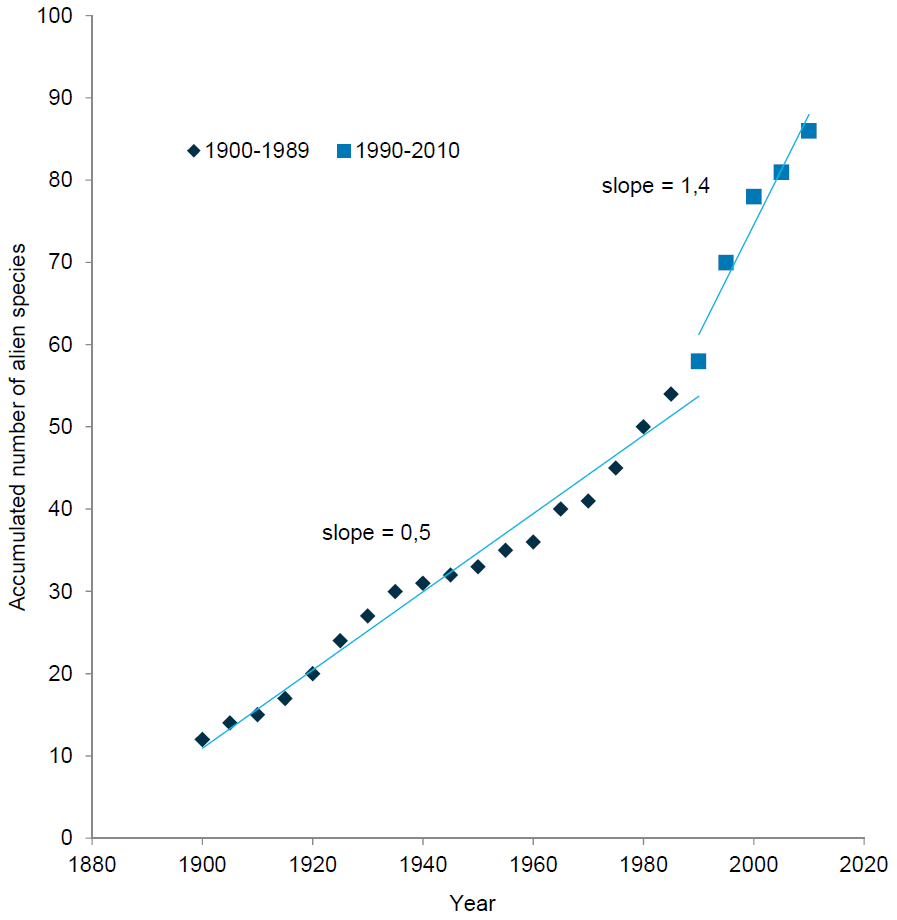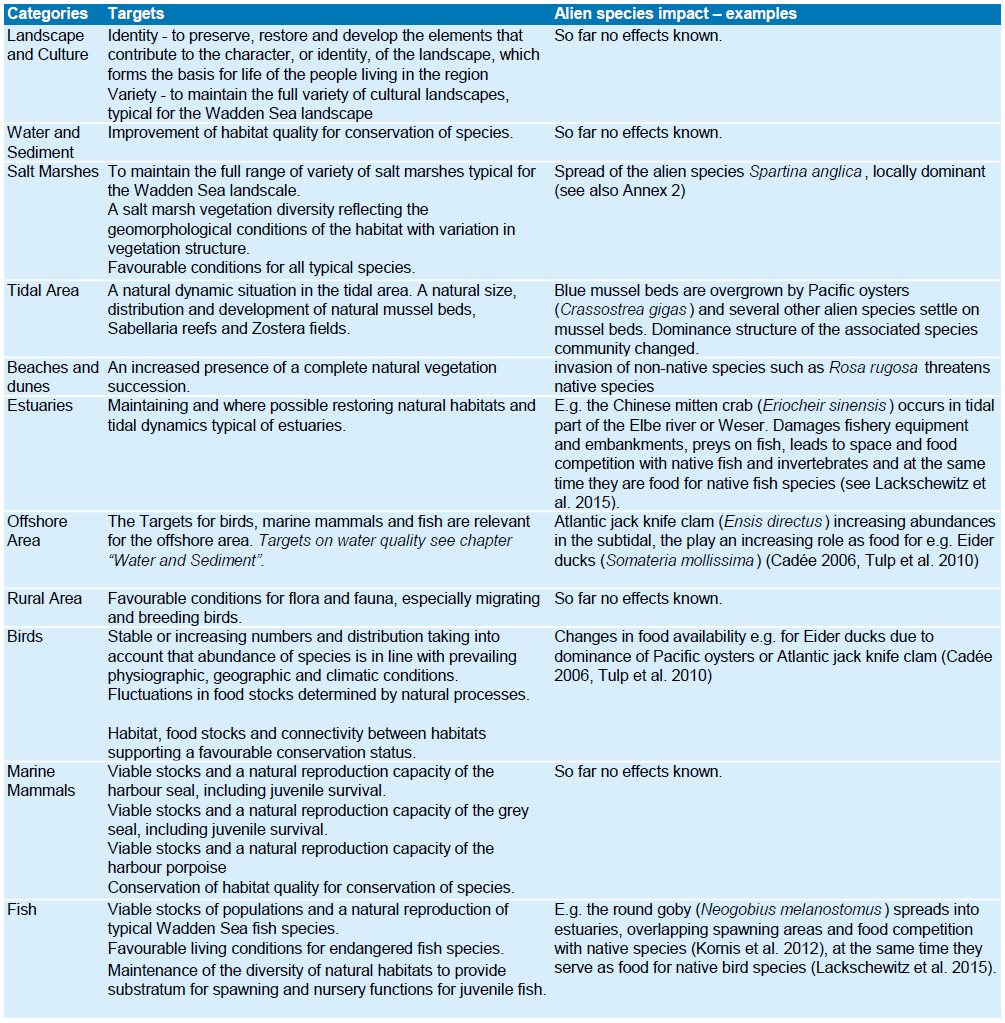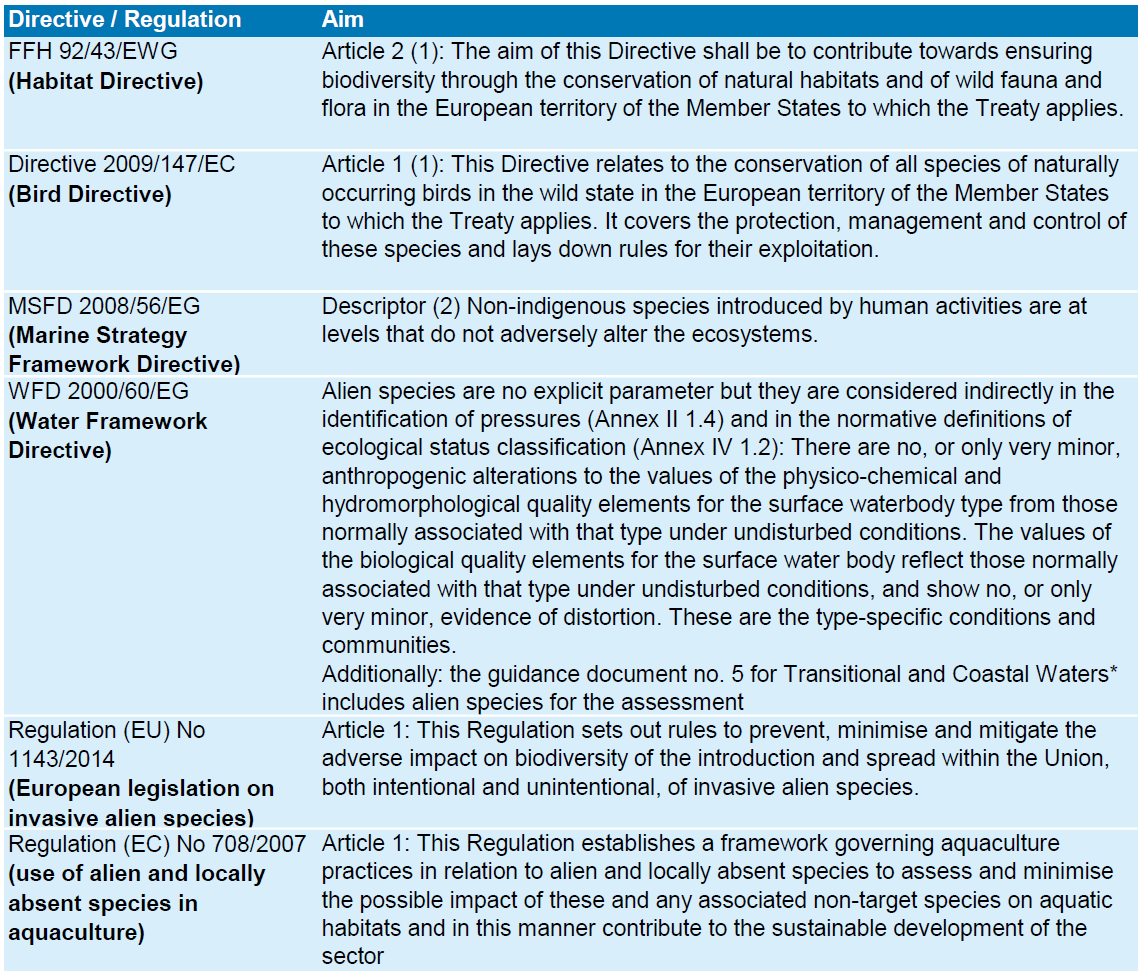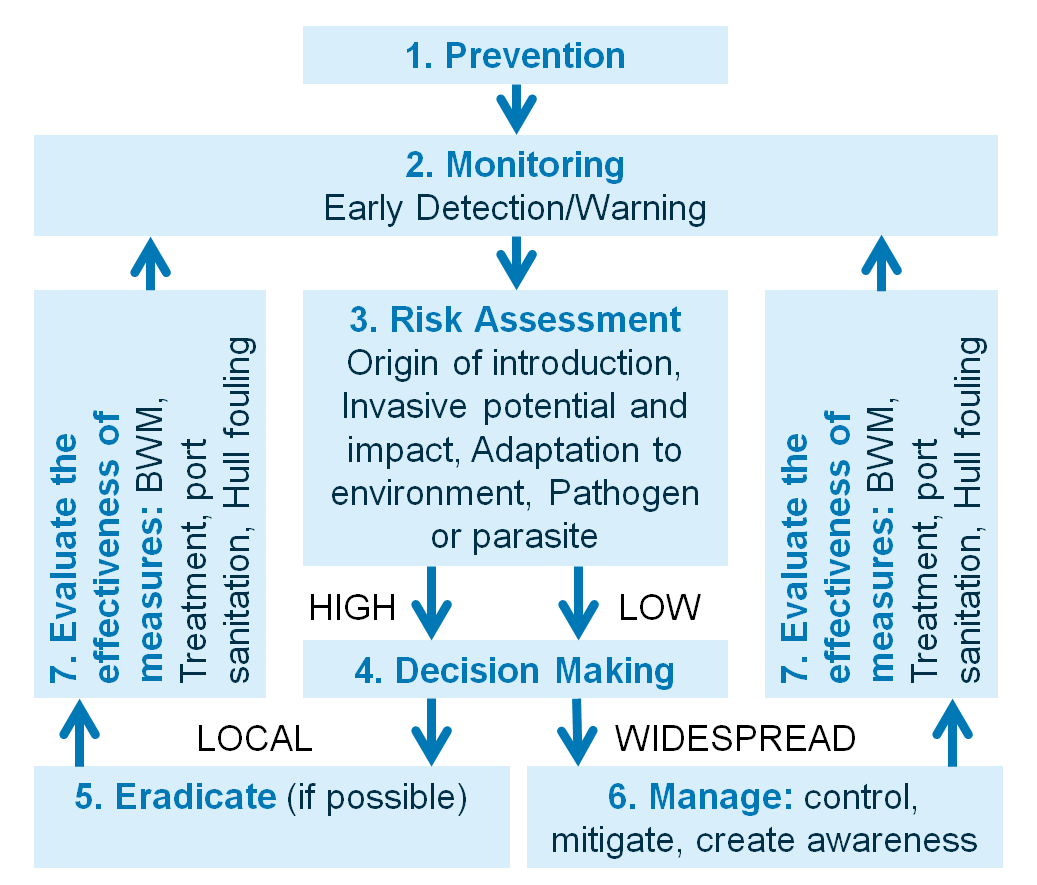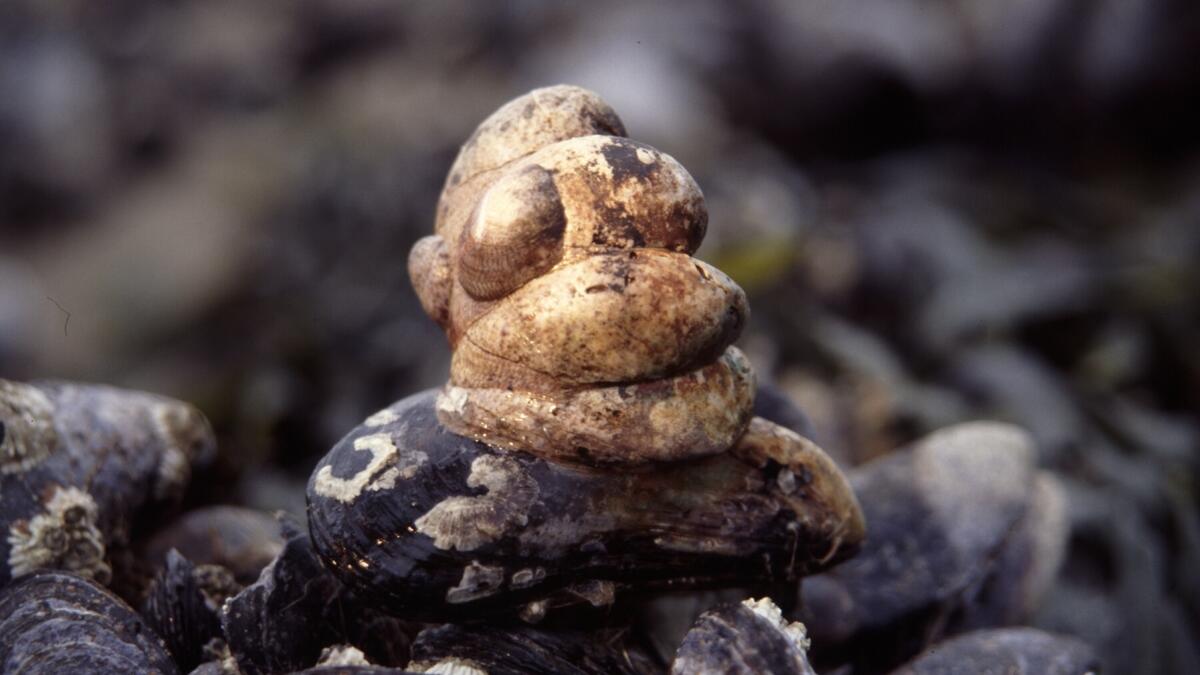
Photo: Christian Buschbaum. Crepidulamytilus.
Alien species
H. Büttger, C. Buschbaum, P. Dolmer, A. Gittenberger, K. Jensen, S. Kabuta, D. Lackschewitz, K. Troost
Published 2017
1. Introduction
The spread of organisms is in principle a natural process. It is, however, limited by natural geographical barriers. Human activities have breached those barriers and have transferred species into areas far beyond their natural range - intentionally and unintentionally (Box 1). With increasing global trade the introduction of alien species outside their natural range speeded up and now raises concern about biological homogenization (Capinha et al., 2015), threatening of native species and ecosystems, threats for humans, their health, and economic aspects (Nehring et al., 2009). The human introduction of alien species, in particular invasive ones, poses a serious threat to the guiding principle of the trilateral Wadden Sea policy “to achieve, as far as possible, a natural and sustainable ecosystem in which natural processes proceed in an undisturbed way” (CWSS, 2010b; see also Bouma et al., 2011). Most alien species became inconspicuous residents and cannot be eliminated without causing collateral damage to the ecosystem. And more alien species are likely to come. This could lead to an increasing number of species and diversity in the Wadden Sea but may also cause biotic homogenization with other areas (Reise et al., 2005; Nehring et al., 2009). Although so far there is no evidence for extinction of native organisms by aliens species in the Wadden Sea area (Wolff, 2000; Buschbaum et al., 2012), some alien species have the potential to alter dominance structures, habitats and trophic regimes, such as e.g., the Pacific oyster Crassostrea gigas and the Japanese seaweed Sargassum muticum (Reise et al., 2005, Figure 1) (for C. gigas compare report "Beds of blue mussels and Pacific oysters") .
 Figure 1. Alien species of the Wadden Sea (from left to right): The Australian barnacle (Austrominius modestus) was introduced with hull fouling, the American slipper limpet (Crepidula fornicata) reached the Wadden Sea with shellfish imports and the Japanese seaweed (Sargassum muticum) was most likely introduced with oyster imports (Lackschewitz et al., 2015) (Photos: Christian Buschbaum).
Figure 1. Alien species of the Wadden Sea (from left to right): The Australian barnacle (Austrominius modestus) was introduced with hull fouling, the American slipper limpet (Crepidula fornicata) reached the Wadden Sea with shellfish imports and the Japanese seaweed (Sargassum muticum) was most likely introduced with oyster imports (Lackschewitz et al., 2015) (Photos: Christian Buschbaum).
In accordance with the UNESCO request of 2009, §26 of the Sylt declaration (CWSS, 2010b) and §33 of the Tønder Declaration (CWSS, 2014), a trilateral strategic framework for dealing with alien species in the Wadden Sea was drafted. This framework considers the main vectors of introduction: ballast water, ship hulls and harbours, aquaculture, recreational crafts and marinas as well as introduction to islands by e.g., planting on dunes or in salt marshes or by escapes from aquariums to freshwater habitats (see also Table 1), although it is often unknown or uncertain how single alien species reached the Wadden Sea. International shipping is the most important vector for alien species introduction (Nehring, 2002; CWSS, 2010a; Buschbaum et al., 2012; see also Schuchardt & Selvigen, 2015) into the Wadden Sea, including transport with ballast water, in the tank sediment or hull fouling (Table 1). The latter is the most import vector with the highest ratio of alien species (Gollasch, 2002). Furthermore, shellfish imports and transport for aquaculture support alien species introduction (Wolff & Reise, 2002; Schuchardt & Selvigen, 2015). Marine alien species reached the Wadden Sea also through secondary dispersal from sites of primary introduction (Buschbaum et al., 2012). Terrestrial and freshwater alien species were mainly intentionally introduced by humans because of their expected ‘beneficial’ effects.
Table 1. Possible aquatic and terrestrial vectors for global dispersal of non-indigenous and invasive alien species, ordered by significance (modified after Gollasch et al., 2013 & fao.org). Table was taken from Schuchardt & Selvigen (2015) and modified (in italics).

The following chapters offer an overview about the current status and trends of marine and terrestrial alien species in the Wadden Sea, summarize directives and regulations relevant for alien species and their assessment in the Wadden Sea area, the progress as well as the current and potential measures of the Trilateral Strategic Framework for Alien Species (TSFAS) and the objectives of the Working Group Alien Species. Finally recommendations for monitoring, research and management are given.
Definitions taken from the Strategic Framework Alien Species
Definitions (based on Definitions of CBD VI/23)Native species"Native species" refers to a species, subspecies or genetically distinct populations, occurring within its natural range (past and present). Alien species*"Alien species" refers to a species, subspecies or genetically distinct populations, introduced outside its natural past or present distribution; includes any part, gametes, seeds, eggs, or propagules of such species that might survive and subsequently reproduce. Invasive alien species"Invasive alien species" means an alien species whose introduction and/or spread threaten biological diversity (For the purposes of the present guiding principles, the term "invasive alien species" shall be deemed the same as "alien invasive species" in decision V/8 of the Conference of the Parties to the Convention on Biological Diversity.). Problem or nuisance speciesA species for which it can be assumed that based on the best available scientific evidence it will have a (significant) negative impact on the conservation goals of a Natura 2000 area. Introduction"Introduction" refers to the movement by human agency, indirect or direct, of an alien species outside of its natural range (past or present). This movement can be either within a country or between countries or areas beyond national jurisdiction. Intentional introduction"Intentional introduction" refers to the deliberate movement and/or release by humans of an alien species outside its natural range. Unintentional introduction"Unintentional introduction" refers to all other introductions which are not intentional. Establishment"Establishment" refers to the process of an alien species in a new habitat successfully producing viable offspring with the likelihood of continued survival. Risk analysis"Risk analysis" refers to: (1) the assessment of the consequences of the introduction and of the likelihood of establishment of an alien species using science-based information (i.e., risk assessment), and (2) to the identification of measures that can be implemented to reduce or manage these risks (i.e., risk management), taking into account socio-economic and cultural considerations. *Species occurring naturally in neighbouring countries of the Wadden Sea and entering independently due to, for instance, climate change do not fall under this definition. |
2. Status and trends
The Wadden Sea is covered by national alien species monitoring programs in Denmark, Netherlands and Germany. Efforts towards a harmonized trilateral and ongoing specific monitoring or detection program for alien species are taking place. A proposal for an overarching trilateral monitoring is currently under development (van der Have & Lensink, 2016). Previous recordings originate from scientific research and since 2009 different national assessments have been carried out (Gittenberger et al., 2009; Gittenberger, 2016; Bouma et al., 2011; Schuchardt & Sevilgen, 2015; van der Have et al., 2015) and, step by step the knowledge of alien species in the Wadden Sea is developing.
In the Netherlands, none of the ongoing monitoring programs for compliance with the Water Framework Directive and/or Natura 2000 regulations specifically focus on recording alien species in the Wadden Sea. In recent years various preliminary studies and alien species-focused surveys were conducted (Gittenberger et al., 2009, 2010, 2012, 2015).
In 2009, the Federal Republic of Germany initiated a specific non-indigenous species (NIS) monitoring survey implementing the needs of the Marine Strategy Framework Directive (MSFD) in accordance with UNESCO´s request. The investigations focused on harbours and aquaculture plots assuming these as hotspots of introductions, in which annual inspections were performed according to a Rapid Assessment (RAS) monitoring program, described in Buschbaum et al., (2012). In the Wadden Sea comprehensive investigations were conducted in 2014/2015 to provide baseline information on the presence of NIS (Rohde et al., 2015; Lieberum & Bock, 2016). Introduced species found in other monitoring programs are also considered for the baseline.
To control introduction and dispersal of NIS along German coastlines, an extended standardized monitoring protocol was implemented in 2016, comprising RAS with additional settlement panels which are deposited for up to four months to discover alien species in the plankton on their search for hard substrate to settle.
The Danish Nature Agency commissioned a study into the requirements for a monitoring program of alien species in Danish waters, including, the Danish Wadden Sea (Andersen et al., 2014). The study proposed to supplement the conventional methods with the eDNA method and that the monitoring programme should cover species groups to the fullest possible extent, i.e., phyto- and zooplankton, macroalgae, benthic organisms, fish and marine mammals and also that it should focus on hot spots.
Now the fundament for further trend evaluation is accomplished (Buschbaum et al., 2012; Lackschewitz et al., 2015; Gittenberger et al., 2015; Rohde et al., 2015) and these activities are comparatively new in relation to all other monitoring efforts in the Wadden Sea. So far, all efforts of alien species detection mainly focus on macro-benthic species, on (semi-)terrestrial and freshwater plants, all other groups are mainly detected by chance. Usually microorganisms are not monitored, only specific investigations provide the detection.
 Figure 2. Origin of alien taxa in the Wadden Sea according to the trilateral alien species list (see Annex 1). Numbers indicate the count of taxa. Data are taken from Gittenberger (2016).
Figure 2. Origin of alien taxa in the Wadden Sea according to the trilateral alien species list (see Annex 1). Numbers indicate the count of taxa. Data are taken from Gittenberger (2016).
The trilateral list of Wadden Sea alien species (Annex 1) comprises the latest status of 90 recorded alien species in the Wadden Sea. It contains marine species and misses terrestrial and freshwater taxa occurring on the Wadden Sea islands. Most marine taxa originate from the Pacific or from the Atlantic (Figure 2).
2.1. Status and trends of marine alien species introduction in the Wadden Sea
In the Netherlands, three surveys were done in 2009, 2011, and 2014 that specifically focused on finding alien species in the Dutch Wadden Sea (Gittenberger et al., 2009, 2010, 2012, 2015). Based on these surveys, close to 30 new alien species were recorded for the Dutch Wadden Sea, raising the number of known aliens in the Dutch Wadden Sea to 81 (Gittenberger et al., 2015, Gittenberger, 2016). Most of these alien species were probably already present in the area far before the first alien species survey in 2009. They might have been missed in the ongoing monitoring programs because these programs tend to focus on soft substrates and natural environments. Most of the alien species in the Wadden Sea are hard substrate-related species that live on floating docks in marinas (Gittenberger et al., 2010).
In the German Wadden Sea, 52 alien species were known to occur until 2010 (Buschbaum et al., 2012). Between 2009 and 2015 a rapid assessment (RAS) took place and nine species were first records for the German Wadden Sea. Detailed information on most of them is summarized in Lackschewitz et al., (2015). Pelagic microbiota are not included. With this, the average number of new introductions discovered in the German Wadden Sea since 2009 counts roughly two alien species per year. Gittenberger (2016) lists a total number of 72 alien species for the German Wadden Sea in 2016, basing on other survey data beyond the RAS (Gittenberger et al., 2013).
For the Danish Waters, Stæhr et al., (2016) reported that from 1900 to 1980, two new species were identified per decade, whereas between 1980 and 2014, 16 new species were identified per decade. For the Danish Wadden Sea 28 alien species were recorded until 2016 (Gittenberger, 2016).
Figure 3 indicates a spatial gradient of the number of registered alien species taxa with decreasing numbers from the Netherlands to Denmark. As in Denmark no specific assessment took place, therefore the number of species might be underestimated.
Between 1900 and 1989 two to four species per decade were introduced into the Wadden Sea area, since 1990 the rate rose to 10–15 species per decade (van de Have & Lensink, 2016, Figure 4).
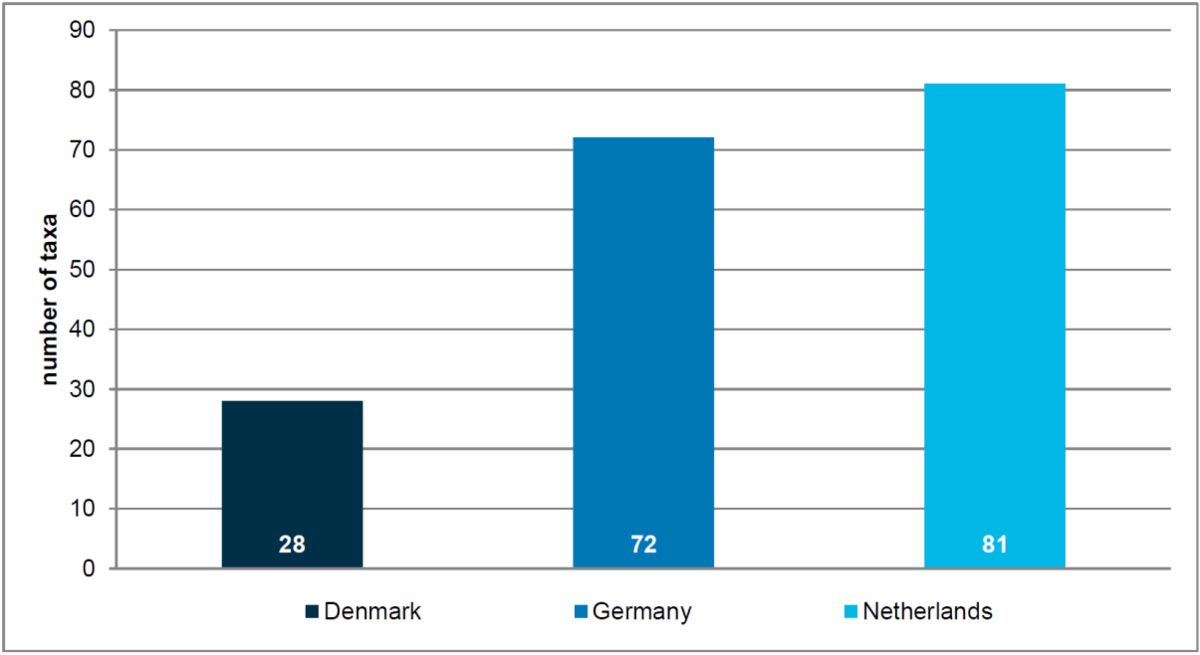 Figure 3. Number of alien benthic species (algae and invertebrates) and one vascular plant in the Netherlands, Germany and Denmark according to the trilateral alien species list (Annex 1, Gittenberger, 2016).
Figure 3. Number of alien benthic species (algae and invertebrates) and one vascular plant in the Netherlands, Germany and Denmark according to the trilateral alien species list (Annex 1, Gittenberger, 2016).
Figure 4. The accumulated number of alien species in the trilateral Wadden Sea is presented for the periods 1900–1989 and 1990–2010. The presumed year of introduction was used for all species (Gittenberger, 2016). The time periods are chosen for comparison with the cumulative number of alien species in Danish marine surveys (Stæhr et al., 2016). Figure taken from van Have & Lensink (2016).
2.2. Status and trends of terrestrial and freshwater alien species introduction in the Wadden Sea area
Alien species occur in all terrestrial habitats in the Wadden Sea region, from intertidal salt marshes via dunes and dune slacks to forests, and in freshwater habitats like ponds and streams. There is no trilaterally harmonized monitoring or management program on alien species in the terrestrial realm of the Wadden Sea Cooperation Area and reliable data for assessing the overall changes in the number and abundance of these alien species or their effects on biodiversity und functioning of ecosystems are not available.
Lensink et al., (2015) provided a list of (potentially) threatening alien species on the Dutch Wadden Sea Islands and a chapter on terrestrial alien species in the German Wadden Sea is included in Schuchardt & Sevilgen (2015). A large share of alien species belongs to vascular plants (e.g., Spartina anglica, Figure 5; Rosa rugosa, Figure 6), but also mosses (Campylopus introflexus) and animals of various taxonomic groups (Branta canadensis, Dreissenia polymorpha, Cyprinus carpio, Felis catus) are considered invasive aliens (for more information on Spartina spp. see Annex).
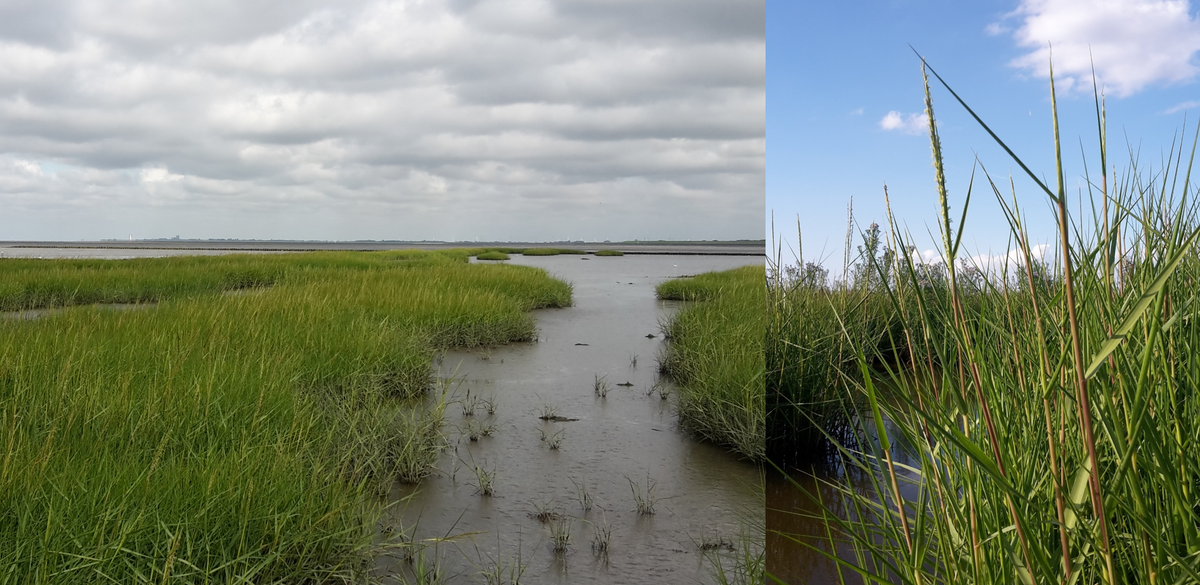 Figure 5. Common cordgrass (Spartina anglica) in the Wadden Sea. Spartina-population overview (left) and detail picture (right) (Photos: Kai Jensen).
Figure 5. Common cordgrass (Spartina anglica) in the Wadden Sea. Spartina-population overview (left) and detail picture (right) (Photos: Kai Jensen).
 Figure 6. Rugosa rose (Rosa rugosa) (Photo: Martin Stock / LKN-SH ).
Figure 6. Rugosa rose (Rosa rugosa) (Photo: Martin Stock / LKN-SH ).
Many of the plant species, nowadays considered as invasive aliens, were intentionally introduced by humans because of their ‘beneficial’ effects: Spartina anglica on tidal flats for coastal erosion control, Rosa rugosa to decrease sand drift in dunes and as a beautiful ornamental plant, Prunus serotina for improving the nutrient availability in nutrient poor coastal forests. Furthermore, aliens threatening the species-rich vegetation of dune slacks, such as Crassula helmsii are widely used aquarium or garden pond plants and have escaped or been released from these anthropogenic habitats. Overall, there is a clear positive relation between the number of inhabitants per island and the occurrence of aliens on Dutch Wadden Sea islands (Lensink et al., 2015). The distance to roads or houses is a major predictor for the occurrence of Rosa rugosa in dunes in Denmark (Kollmann et al., 2007).
It is not always easy to determine whether a species is to be considered native or alien: While foxes are native to the Wadden Sea region, they have not been established naturally on the Wadden Sea islands and thus they could be called alien species there. The recent invasion of dunes in Denmark by the grass Deschampsia flexuosa, which is native and wide-spread in inland ecosystems but which was absent from coastal dunes half a century ago, is another example (Nielsen et al., 2011). Finally, it may be questioned whether the grass Spartina anglica, which was considered as the ‘most important invasive plant in the Wadden Sea’ by Nehring et al., (2009), and which is listed by the World Conservation Union to be among the 100 ‘World’s Worst’ invaders (Lowe et al., 2000), is an alien in the Wadden Sea region at all: The species ‘naturally evolved’ by spontaneous hybridization between a native European and an introduced American Spartina species and subsequent ‘natural polyploidization’ in southern England at the end of the 19th century. Later, the species was deliberately introduced and planted in the Wadden Sea region but would probably also have expanded naturally from Southern England to the Wadden Sea (see Annex 2 and report "Salt marshes").
3. Assessment
3.1. Policies and Wadden Sea Plan Targets relevant for alien species in the Wadden Sea
In the Wadden Sea Plan 2010 (Common Wadden Sea Secretariat 2010a) several habitat targets were defined which might be affected by alien species (Table 2), but no specific targets for alien species were formulated.
Current national policies applied for alien species management in the Wadden Sea are based upon relevant regional, international and European policies (Schuchardt & Sevilgen, 2015,van der Have et al., 2015). International policies include the IMO- Ballast Water Convention, CITES-trade in endangered species and IPPC (plant health). Several global policies, regional conventions, articles and guidelines including the Biodiversity Convention, and Nature conservation guidelines are already integrated within the national policies for alien species management.
Relevant EU directives include Habitat and Bird Directives, Marine Strategy Framework Directive, Water Framework Directive and the Council Regulations No. 1143/2014/EC (IAS Prevention and management), No.708/2007/EC (IAS in aquaculture) and No. 338/97/EC (IAS in trade).
The EU Regulation on invasive alien species addresses the problems on alien species directly and several European Directives address them indirectly (Table 3). In the Marine Strategy Framework Directive (MSFD) the descriptor (2) examines alien species and aims “Non-indigenous species introduced by human activities are at levels that do not adversely alter the ecosystems”. Denmark, Germany and the Netherlands have defined the good ecological status (GES) for this descriptor differentially and the definitions were considered inadequate (Denmark, the Netherlands) or partially inadequate (Germany, Dupont et al., 2014, see de Have & Lensink, 2016). None or a low introduction rate of alien species per year could be an evaluation method of alien species according to the MSFD but needs further discussion and should be harmonized within the Wadden Sea Cooperation.
Table 2. Targets of the Wadden Sea Plan 2010 (CWSS, 2010b) which might be affected by alien species. Examples of alien species impacts are given.
Table 3. Overview of relevant European Directives and Regulations which address alien species directly or indirectly.
3.2. The Trilateral Strategic Framework for Alien Species and objectives of the Working Group Alien Species
At the 11th Trilateral Governmental Conference on Sylt (2010), it was agreed to develop a common strategy to deal with alien species (CWSS, 2010b), taking account of the request of the UNESCO World Heritage Committee from 2009 to “implement a strict monitoring programme to control invasive species associated with ballast waters and aquaculture in the property”. Following this decisions a Trilateral Strategic Framework for Alien Species (TSFAS) was elaborated. At the 12th Trilateral Wadden Sea Conference in Tønder (2014), it was agreed to further develop the TSFAS and to coordinate the further development of an alien species management action plan. The trilateral Task Group Management and Monitoring (TG-MM) was mandated to coordinate these initiatives with input from a Working Group Alien Species (WG AS).
Current alien species management measures in the Wadden Sea are described in the draft TSFAS which consists of five main elements: (1) prevention; (2) early warning and rapid response; (3) eradication and control; (4) raising awareness and (5) implementation. TG-MM and WG-AS have since 2014 worked on the development of an alien species management and action scheme (Figure 7), which is based on the five elements of the TSFAS. The work done so far is briefly described below.
Project 1.Development of an inventory of alien species related policies for the Wadden Sea
This project was completed in 2015. Existing national, European, and international policies related to alien species management were evaluated for their relevance for the Wadden Sea. Furthermore, priorities for the trilateral alien species management and action plan were defined (Schuchardt & Sevilgen, 2015; and van der Have et al., 2015).
Project 2. Development of a trilateral alien species list
This work was completed for the marine part of the Wadden Sea (Gittenberger, 2016; see Annex 1). Work on the terrestrial part of the Wadden Sea is in progress in Denmark and Germany (Büttger et al., in prep.), and has been completed in the Netherlands (Lensink et al., 2015).
Project 3. Development of a proposal for a harmonised monitoring program for alien species in the Wadden Sea (TMAP-AS)
The project objective is to harmonise existing national monitoring and assessment activities with the desired TSFAS-based monitoring requirements for alien species in the Wadden Sea (van der Have & Lensik, submitted).
The focus of WG-AS activities in the coming year will be on the following
- Extending the current list of aquatic alien species to cover terrestrial alien species in the Wadden Sea area;
- Developing a common methodology for alien species risk assessment;
- Developing a scheme for awareness raising.
Figure 7. A schematic presentation of a management action plan for alien species in the Wadden Sea (developed by WG-AS, 2015).
3.3. Measures of the Trilateral Strategic Framework for Alien Species management in the Wadden Sea
The relevant national, regional and international policies, guidelines and directives (see section 3.1) inform the TSFAS which is in turn implemented in the trilateral Wadden Sea through measures including prevention, early warning and rapid response, eradication and control and raising awareness and education in the relevant communities. The current application of these measures is shown below:
(1) Prevention: All three Wadden Sea countries have ratified the IMO-Ballast Water Management Convention, which is in force since September 2017. Specific measures against introduction of alien species to the Wadden Sea through the import of seed mussels for aquaculture have been developed in the Netherlands. Measures against mussel transportation are irrelevant for Germany and for Denmark, as in Germany the import of seed mussels to the Wadden Sea is forbidden and there is no mussels farming activity in Denmark.
(2) Early warning and rapid response to new alien species introductions: Monitoring and surveillance teams in the Netherlands carry out risk assessment procedures to inform decision making at the Ministry of Economic Affairs. In Germany, a benthic monitoring network and a neobiota knowledge platform is set up to record new introductions to the Wadden Sea. In Denmark, various monitoring activities are in place to enhance the recording of new introductions. A common approach to early warning and rapid assessment with relevant procedures and protocols needs to be developed with a website to facilitate the process of information sharing.
(3) Eradication and control: Current measures to control alien species transportation are a necessity. In the Netherlands, the management and control systems for mussel transport are enforced by Dutch law specifically for importing mussels into the Wadden Sea. This management and control systems based on the Shellfish Import Monitoring Protocol (Gittenberger, 2010) is applied during mussel transportation from the Scheldt estuaries to the Wadden Sea. More effort is needed to develop possible eradication and control measures for trilateral application in future. These may include exchange of experiences and best practices in the field and in the management sector.
(4) Raising awareness and education: More effort is needed to develop the elements of the TSFAS at national and trilateral levels. Informing stakeholders about alien species introductions is part of the management action scheme for alien species (see Figure 7).
4. Recommendations
Following the current status and trend of alien species and the trilateral progress in alien species assessment in the Wadden Sea area, recommendations for monitoring, management and research are given.
Monitoring
- A proposal for a harmonized monitoring program for alien species in the Wadden Sea, which should be in line with the requirements of OSPAR and MSFD: Currently, a strategy for a Monitoring Programme on alien species in the Wadden Sea is under preparation (van der Have & Lensink, submitted);
- So far, registration of alien species in the Wadden Sea focusses on macrobenthic species in harbours, marinas and at shellfish farming sites. Future monitoring should consider also phytoplankton, zooplankton, fish and birds as well as terrestrial and freshwater species. The observation of viruses and other micro-organism should not be disregarded completely. Alien species monitoring should be both, incorporated in established trilateral monitoring parameters and partly set up new. Tidal flats and subtidal soft bottom communities should be included, as well as artificial hard substrates. The monitoring of alien species in salt marshes and dunes could be easily incorporated in the existing monitoring procedures for these habitats. The monitoring program needs a solid financial fundament and has to be in line with the requirements of the MSFD for Descriptor 2 and Regulation 1143/2014 on invasive alien species;
- There is a need to develop a trilateral Wadden Sea early warning and reporting system. Supporting elements for such a system include a harmonised guideline for risk assessment;
- There is need to develop a Wadden Sea area communication and education plan for the Alien Species Strategy implementation;
- The trilateral alien species list should cover zooplankton, phytoplankton, fish, birds and terrestrial taxa as well;
- A common trilateral portal should be installed to support network and exchange including a central Wadden Sea species list as well as species alerts.
Management
- Already established populations of alien species have to be accepted and cannot be removed. All measures for managing alien species should be based on a critical evaluation of collateral damages;
- Ship biofouling is the most important vector for alien species to arrive in the Wadden Sea and adjacent areas. Therefore, the three countries should discuss options for the implementation of actions defined in the IMO's Guidelines for the Control and Management of Ships' Biofouling but also on treatment of leisure boat hulls;
- Aquaculture related import and transport activities support the spread of alien species. Therefore, a trilateral common policy on shellfish transportation in the Wadden Sea is needed;
- Eradication has the risk of unforeseeable collateral damages. Therefore, introduction of alien species should be prevented by deteriorating the vectors of introduction.
Research
- Effects of alien species on food webs and communities need higher attention in research;
- The potential benefits (early detection, easy and efficient) of the eDNA methodology for alien species detection should be investigated in a pilot study.
5. Summary
Although so far there is no evidence that alien species have caused the extinction of native species in the Wadden Sea, and most alien species become inconspicuous residents, some alien species have the potential to alter dominance structures, habitats and trophic regimes. In consequence of the Sylt declaration (2010) and Tønder Declaration (2014) a draft trilateral strategic framework for dealing with alien species in the Wadden Sea was compiled including the need of trilateral monitoring program for alien species which is currently under preparation.
At present the trilateral alien species list of the Wadden Sea comprises 90 alien species, disregarded phytoplankton, zooplankton, fish, birds and terrestrial species taxa. Most of these marine alien taxa originate from the Pacific or from the Atlantic. Main vectors are transoceanic shipping and aquaculture; direct introduction is the most important factor for terrestrial plants.
Current national policies applied for alien species management in the Wadden Sea are transpositions of relevant international and European policies. International policies include the IMO- Ballast Water Convention, CITES-trade in endangered species and IPPC (plant health). Several global policies, regional conventions, articles and guidelines including Biodiversity Convention, and Nature conservation guidelines are already integrated with the national policies for alien species management. Relevant EU directives include Habitat and Bird Directives, Marine Strategy Framework Directive, Water Framework Directive and the Council Regulations No. 1143/2014/EC (IAS Prevention and management), No.708/2007/EC (IAS in aquaculture) and No. 338/97/EC (IAS in trade).
The draft Trilateral Strategic Framework for Alien Species (TSFAS) contains activities which include prevention; early warning and rapid response; eradication and control; raising awareness and implementation of the alien species management strategy in the Wadden Sea. The framework still needs to be adopted by the Trilateral Wadden Sea Cooperation.
The given recommendations focus on the implementation of a harmonized alien species monitoring program including macrobenthos, algae, phytoplankton, zooplankton, fish, birds and terrestrial species (e.g., plants, mammals).
About the authorsH. Büttger1, C. Buschbaum2, P. Dolmer3, A. Gittenberger4, K. Jensen5, S. Kabuta6, D. Lackschweitz2, K. Troost7 1BioConsult SH, Schobüller Str. 36, 25813 Husum, DE; 2AWI Sylt, Hafenstraße 43, 25992 List/Sylt, DE; 3Orbicon A/S, Jens Juuls Vej 16, 8260 Viby J, DK; 4GiMaRIS, J.H. Oortweg 21, 2333 CH Leiden, NL; 5University of Hamburg, Ohnhorststr. 18, 22609 Hamburg, DE; 6Rijkswaterstaat, Ministry of Infrastructure and the Environment, Amsterdam, NL; 7Wageningen Marine Research, Korringaweg 5, 4401NT Yerseke, NL |
References
Andersen, J.H., S.A. Pedersen, J. Thaulow, F. Stuer-Lauridsen & S. Cochrane (2014) Monitoring of non-indigenous species in Danish marine waters. Background and proposals for a monitoring strategy and a monitoring network. Danish Nature Agency. 55 pp.
Bouma, S., S. Gollasch & W. Lengkeek (2011) Neobiota in the Wadden Sea including recommendations for a trilateral strategy. Report nr 11-097. Prepared for Programma Rijke Waddenzee and the Common Wadden Sea Secretariat, Wilhelmshaven, Germany. 80 pp.
Büttger, H., Alpert, S, van der Have, T. & Goldberg, C. (in prep.) Alien species on the German and Danish islands - Occurrence and ecological risks. CWSS.
Buschbaum C., D. Lackschewitz & K. Reise (2012) Nonnative macrobenthos in the Wadden Sea ecosystem. Ocean & Coastal Management 68: 89-101.
Cadée, G. C. (2006) Eidereenden op Ensis directus dieet. Spirula 351, S: 86–87.
Capinha, C., F. Essl, H. Seebens, D. Moser & H.M. Pereira (2015) The dispersal of alien species redefines biogeography in the Anthropocene. Science, 348(6240): 1248-1251.
CWSS (2010a) Wadden Sea Plan 2010. Eleventh Trilateral Governmental Conference on the Protection of the Wadden Sea. Common Wadden Sea Secretariat, Wilhelmshaven, Germany.
CWSS (2010b. Sylt Declaration. Ministerial Council Declaration of the Eleventh Trilateral Governmental Conference on the Protection of the Wadden Sea. Common Wadden Sea Secretariat, Wilhelmshaven, Germany.
CWSS (2014) Toender Declaration. Ministerial Council Declaration of the 12th Trilateral Governmental Conference on the Protection of the Wadden Sea. Common Wadden Sea Secretariat, Wilhelmshaven, Germany.
Dupont, C., A. Belin, G. Moreira, B. Vermonden B., S. Cochrane, L. Wilson, C. Emblow, B. Kater, S. Des Clercs, W. Parr, C. Le Visage, N. Green, J. Cools & F. Thomsen (2014) Article 12 Technical assessment of the MSFD 2012 obligations North-East Atlantic Ocean. Final version. Milieu Ltd, Brussels, 43 pp.
Gittenberger, A. (2016) Alien species of the Wadden Sea database. Issued by Office of risk assessment and research, the Netherlands Food and Consumer Product Safety Authority. Accessed on 9-6-2016.
Gittenberger, A., M. Rensing, H. Stegenga & B.W. Hoeksema (2010) Native and non-native species of hard substrata in the Dutch Wadden Sea. Nederlandse Faunistische Mededelingen 33: 21-75.
Gittenberger, A., M. Rensing, R. Dekker, P. Niemantsverdriet, N. Schrieken & H. Stegenga (2015) Native and non-native species of the Dutch Wadden Sea in 2014. GiMaRIS rapport 2015_08: 93 pp. i.o.v. Ministerie Economische Zaken; Bureau Risicobeoordeling en Onderzoeksprogrammering (BuRO).
Gittenberger, A., Rensing, M., Schrieken, N. & H. Stegenga (2012) Waddenzee inventarisatie van aan hard substraat gerelateerde organismen met de focus op exoten, zomer 2011. GiMaRIS rapport 2012.01: 61 pp. i.o.v. de Producentenorganisatie van de Nederlandse Mosselcultuur.
Gittenberger, A., Rensing, M., Niemantsverdriet, P., Schrieken, N. & H. Stegenga (2013) Native and non-native species of hard substrata in the Schleswig-Holstein Wadden Sea 2012-2013. GiMaRIS rapport 2013_23: 105 pp. i.o.v. Erzeugerorganisation schleswig-holsteinischer Muschelzüchter e.V..
Gittenberger, A., Rensing, M., Stegenga, H. & B.W. Hoeksema (2009) Inventarisatie van de aan hard substraat gerelateerde macroflora en macrofauna in de Nederlandse Waddenzee. GiMaRIS rapport 2009.11: 63 pp. i.o.v. Team Invasieve Exoten, Ministry of Agriculture, Nature and Food Quality, Den Haag, The Netherlands.
Gollasch, S. (2002) The importance of ship hull fouling as a vector of species introductions into the North Sea. Biofouling 18: 105-112.
Kollmann, J., R.H. Jørgensen & J. Roelsgaard (2009) Establishment and clonal spread of the alien shrub Rosa rugosa in coastal dunes—a method for reconstructing and predicting invasion patterns - Landscape and Urban Planning 93: 194-200.
Kornis, M.S., N. Mercado-Silva & M.J. Vander Zanden (2012) Twenty years of invasion: a review of round goby Neogobius melanostomus biology, spread and ecological implications. Journal of Fish Biology 80: 235–285.
Lackschewitz D., K. Reise, C. Buschbaum & R. Karez (2015) Neobiota in deutschen Küstengewässern. Schriftenreihe LLUR SH – Gewässer; D 25, 216 S.
Lensink R., T.M. van der Have, R.J. van der Haterd, J.A. Inberg, D.M. Soes & B. Achterkamp (2015) Alien species on the Dutch Wadden Sea Islands: Occurrence and ecological risks. Report No 15-077.
Lieberum C. & G. Bock (2016) Neobiota Standard. Endbericht. LLUR 0608.451413.
Lowe S., M. Browne, S. Boudjelas & M. De Poorter (2000) 100 of the World’s Worst Invasive Alien Species. A selection from the Global Invasive Species Database. Published by The Invasive Species Specialist Group (ISSG) a specialist group of the Species Survival Commission (SSC) of the World Conservation Union (IUCN), 12pp. First published as special lift-out in Aliens 12, December 2000. Updated and reprinted version: November 2004.
Nehring, S. (2002) Biological invasions into German waters: an evaluation of the importance of different human-mediated vectors for nonindigenous macrozoobenthic species. In: Leppäkoski, E., S. Gollasch & S. Olenin (Eds.), Invasive Aquatic Species of Europe - Distribution, Impacts and Management. Kluwer Academic Publishers, Dordrecht: 373-383.
Nehring S., K. Reise, N. Dankers & P.S. Kristensen (2009) Alien species. Thematic Report No. 7. In: Marencic, H. & Vlas, J. de (Eds), 2009. Quality Status Report 2009. Wadden Sea Ecosystem No. 25. Common Wadden Sea Secretariat, Trilateral Monitoring and Assessment Group, Wilhelmshaven, Germany.
Nielsen K.E., H.J. Degn, C. Damgaard, M. Bruus & B. Nygaard (2011) A native species with invasive behaviour in coastal dunes: Evidence for progressing decay and homogenization of habitat types. Ambio 40: 819-823.
Reise, K., N. Dankers & K. Essink (2005) Introduced Species. Wadden Sea Ecosystem 19: 155-161.
Rohde S., A. Markert, P. Schupp & A. Wehrmann (2015) Neobiota-Basislinie in niedersächsischen Küstengewässern. Bericht erstellt im Auftrag des NLWKN und NLPV.
Schuchardt, B. & D.S. Sevilgen (2015) Invasive alien species (IAS) policies and management in the German Wadden Sea.
Stæhr P.A., H.H. Jakobsen, J.L.S. Hansen, P. Andersen, M. Storr-Paulsen, J. Christensen, S. Lundsteen, C. Göke & M.-C. Carausu (2016) Trends in records and contribution of nonindigenous species (NIS) to biotic communities in Danish marine waters. Aarhus University, DCE – Danish Centre for Environment and Energy, 44 pp. Scientific Report from DCE – Danish Centre for Environment and Energy No. 179
Tulp, I., J. Crayermeersch, M. Leopold, C. van Damme, F. Fey & H. Verdaat (2010) The role of the invasive bivalve Ensis directus as food source for fish and birds in the Dutch coastal zone. Estuarine, Coastal and Shelf Science 90/3,S: 116–128. DOI: 10.1016/j.ecss.2010.07.008.
van der Have, T. & R. Lensik (submitted) Trilateral Monitoring and Assessment Programme for Alien Species. Developing a proposal for the trilateral Wadden Sea area.
van der Have, T.M., B. van den Boogaard, R. Lensink, D. Poszig & C.J.M. Philippart (in prep.) Alien Species in the Dutch Wadden Sea: Policies and Management. Report nr 15-126.
Wolff, W.J. & K. Reise (2002) Oyster imports as a vector for the introduction of alien species into northern and western European waters. In: Leppäkoski, E., S. Gollasch & S. Olenin (Eds.), Invasive Aquatic Species of Europe - Distribution, Impacts and Management. Kluwer Academic Publishers, Dordrecht: 373-383.
Wolff, W.J. (2000) Causes of extirpations in the Wadden Sea, an estuarine area in The Netherlands. Conservation Biology 14: 876-885.
This report should be cited as: Büttger, H., Buschbaum, C., Dolmer, P., Gittenberger, A., Jensen, K., Kabuta, S., Lackschewitz, D., & Troost, K. (2017). Wadden Sea Quality Status Report: Alien species. Common Wadden Sea Secretariat. https://doi.org/10.5281/zenodo.15221049
All 2017 reports may be cited collectively as: Kloepper, S., Baptist, M. J., Bostelmann, A., Busch, J.A., Buschbaum, C., Gutow, L., Janssen, G., Jensen, K., Jørgensen, H.P., de Jong, F., Lüerßen, G., Schwarzer, K., Strempel, R., & Thieltges, D. (2017). Wadden Sea Quality Status Report. Common Wadden Sea Secretariat, Wilhelmshaven, Germany. Downloaded DD.MM.YYYY. qsr.waddensea-worldheritage.org

